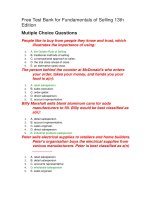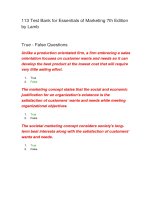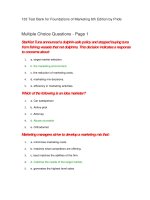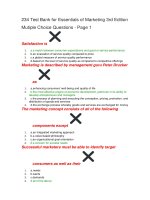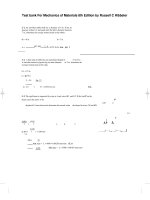Test bank for fundamentals of nursing 3rd edition by harkreader
Bạn đang xem bản rút gọn của tài liệu. Xem và tải ngay bản đầy đủ của tài liệu tại đây (55.42 KB, 8 trang )
buy this full document at
Harkreader: Fundamentals of Nursing, 3rd Edition
Test Bank
Chapter 1: The Nursing Profession
MULTIPLE CHOICE
1. Which of the following statements is an accurate description of nursing?
1. Nursing is a profession dependent upon the physician.
2. It is the role of the physician, not the nurse, to help clients understand their health.
3. Nursing includes the diagnosis and treatment of human responses to health and
illness.
4. Nursing includes the diagnosis and cure of human diseases and any potential
health problems.
ANS: 3
Nursing is primarily concerned with the diagnosis and treatment of human responses to health
and illness. This description of nursing is contained in the American Nurses Association
Nursing’s Social Policy Statement. Nursing practice does not depend exclusively on the
physician. Nurses do help clients understand their health. The scope of nursing practice extends
beyond “cure.” It focuses on “care.”
DIF: Cognitive Level: Knowledge
KEY: Nursing Process Step: N/A
REF: Page: 1-2
MSC: NCLEX: N/A
2. Schools of nursing based on Florence Nightingale’s model of classroom and clinical experience
began to appear in the United States after the American Civil War. What influence did war have
on nursing education?
1. no true influence
2. increased demand for trained nurses
3. increased paternalism
4. increased nursing shortages in the hospitals
ANS: 2
Advances in military technology escalated the rates of crippling injuries, loss of limbs, and
mortality. This led to an increased demand for trained nurses.
DIF: Cognitive Level: Knowledge
KEY: Nursing Process Step: N/A
REF: Page: 1-3
MSC: NCLEX: N/A
3. Which of the following organizations are for professional nurses?
1. American Nurses Association and International Council of Nurses
2. Association of American Registered Nurses
3. American Nurses Association and National Nursing Coalition
4. American Nurses League and National Association for Nursing
buy this full document at
Full file at />ANS: 1
The two professional nursing organizations are American Nurses Association and the
International Council of Nurses. The other organizations are not recognized professional
organizations.
DIF: Cognitive Level: Knowledge
KEY: Nursing Process Step: N/A
REF: Page: 1-12
MSC: NCLEX: N/A
4. Professionalism can be best defined by which of the following statements?
1. It requires at least a high school education before one can join.
2. It is upholding the laws of, and being governed by, the states.
3. It is behavior that upholds a profession’s status, methods, character, and standards.
4. It consists of actions that uphold the level of knowledge consistent with
competency.
ANS: 3
Professionalism is behavior that upholds the status, methods, character, and standards of a given
profession.
DIF: Cognitive Level: Knowledge
KEY: Nursing Process Step: N/A
REF: Page: 1-11
MSC: NCLEX: N/A
5. Licensure as a registered nurse (RN) in the United States is a credential that is a(n):
1. proof in writing of qualifications.
2. formal mandatory process whereby the state grants a person the right to provide
professional nursing services.
3. formal mandatory process whereby a nongovernment agency grants a person the
right to provide professional nursing services.
4. achievement that validates a high level of competency through successful scoring
on the NCLEX–RN.
ANS: 2
A graduate is eligible for licensure as an RN in a particular state after successfully passing the
National Council Licensing Examination for Registered Nurses (NCLEX–RN).
DIF: Cognitive Level: Knowledge
REF: Page: 1-10
KEY: Nursing Process Step: N/A
MSC: NCLEX: Safe, Effective Care Environment
6. The goal for continuing education for nurses is to:
1. promote quality and develop clinical expertise.
2. ensure that nurses have a lifelong love of learning.
3. provide a revenue stream for local educational organizations.
4. ensure that nurses are completely competent in all clinical areas.
ANS: 1
Elsevier items and derived items © 2007 by Saunders, an imprint of Elsevier Inc.
Full file at />The goal for continuing education for nurses is to promote quality and competency in nursing.
Many nurses practice in a limited number of practice settings and therefore cannot be completely
competent in all clinical areas.
DIF: Cognitive Level: Knowledge
REF: Page: 1-11
KEY: Nursing Process Step: N/A
MSC: NCLEX: Safe, Effective Care Environment
7. Which of the following is an example of an organization that focuses on a specific area of
nursing practice?
1. American Nurses Association
2. National League for Nursing
3. Sigma Theta Tau
4. Oncology Nursing Society
ANS: 4
Specialty nursing organizations, such as the Oncology Nursing Society, focus on specific areas of
nursing practice and strive to improve the standard of practice and welfare of nurses in that
specialty area.
DIF: Cognitive Level: Comprehension
KEY: Nursing Process Step: N/A
REF: Page: 1-9
MSC: NCLEX: N/A
8. A nurse uses decision-making skills many times during the work shift on the clinical nursing
unit. This nurse is engaged in which of the following roles?
1. critical thinking
2. caregiver
3. communicator
4. teacher
ANS: 1
The critical thinking role of the nurse involves decision-making skills. The caregiver provides
care and treatment, the communicator maintains open and consistent communication with
clients, and the teacher provides information to clients and family members about health.
DIF: Cognitive Level: Application
KEY: Nursing Process Step: N/A
REF: Page: 1-13
MSC: NCLEX: N/A
9. A client asks the nurse what types of foods to eat to lower the risk of heart disease. In answering
the client, the nurse engages in which of the following roles?
1. communicator
2. teacher
3. critical thinker
4. caregiver
ANS: 2
Elsevier items and derived items © 2007 by Saunders, an imprint of Elsevier Inc.
Full file at />The nurse as teacher provides information to clients and family members about health. The
communicator maintains open and consistent communication with clients, the critical thinking
role of the nurse involves decision-making skills, and the caregiver provides care and treatment.
DIF: Cognitive Level: Application
KEY: Nursing Process Step: Assessment
REF: Page: 1-13
MSC: NCLEX: Physiological Integrity
10. A nurse states an intention to conduct nursing research. A colleague asks whether the nurse plans
to obtain a(n):
1. associate degree.
2. specialty nursing certificate.
3. baccalaureate degree.
4. graduate degree.
ANS: 4
A graduate degree in nursing is usually the minimal educational requirement for conducting
nursing research, although nurse generalists (those with diplomas or undergraduate degrees) do
participate in research. A specialty nursing certificate is obtained through a specialty nursing
organization and is not an academic credential.
DIF: Cognitive Level: Application
KEY: Nursing Process Step: N/A
REF: Page: 1-13
MSC: NCLEX: N/A
11. When a nurse helps a client return to a maximal state of functioning, the nurse is performing
which of the following roles?
1. caregiver
2. advocate
3. researcher
4. rehabilitator
ANS: 4
The nurse is acting in the rehabilitator role when working with a client to return that client to a
maximal state of functioning. This is often done in conjunction with workers in other health care
disciplines, such as physical therapists.
DIF: Cognitive Level: Knowledge
REF: Page: 1-13
KEY: Nursing Process Step: Planning
MSC: NCLEX: Health Promotion and Maintenance
12. A nurse who is thinking about where to practice nursing considers that there is a decline in the
number of nurses working in:
1. long-term care facilities.
2. home health agencies.
3. occupational health settings.
4. hospitals.
ANS: 4
Elsevier items and derived items © 2007 by Saunders, an imprint of Elsevier Inc.
Full file at />Hospitals have decreased the number of in-patient days to contain costs. Clients are no longer
treated in the hospital until they are “well enough” to go home, instead the trend is to admit
surgical clients for a shorter term, and then discharge to home health or rehabilitation.
DIF: Cognitive Level: Knowledge
KEY: Nursing Process Step: N/A
REF: Page: 1-7
MSC: NCLEX: N/A
13. When one is deciding whether to perform a “cutting edge” procedure, what is the focus?
1. the cost of the procedure
2. the reason for the procedure
3. the efficacy of the procedure
4. the ethics of the procedure
ANS: 2
Because of advancing research, many procedures require extensive ethical and moral review, and
the focus has become “why are we doing this?”
DIF: Cognitive Level: Application
KEY: Nursing Process Step: N/A
REF: Page: 1-6
MSC: NCLEX: N/A
14. A nurse considering how to plan a nursing career could look at which of the following
demographic changes as a social issue that affects nursing?
1. decreasing life span
2. growing number of elderly
3. increased tendency toward rural living
4. higher mortality rates for older adults
ANS: 2
The number of older adults in the population is increasing. Life span is increasing and mortality
rates are decreasing. The greatest numbers of people live in urban areas.
DIF: Cognitive Level: Knowledge
KEY: Nursing Process Step: N/A
REF: Page: 1-7
MSC: NCLEX: N/A
15. The purpose of the Health Insurance Portability and Accountability Act of 1996 was to:
1. give health insurance companies access to medical records.
2. ensure that no one sees medical records.
3. create strict guidelines regarding access to medical records.
4. make it illegal to discuss health information with the client’s family.
ANS: 3
The Health Insurance Portability and Accountability Act (HIPAA) of 1996 created strict
guidelines for giving information to anyone who might ask for access to medical records.
Medical records may be released only with the client’s permission.
DIF: Cognitive Level: Knowledge
KEY: Nursing Process Step: N/A
REF: Page: 1-6
MSC: NCLEX: N/A
Elsevier items and derived items © 2007 by Saunders, an imprint of Elsevier Inc.
Full file at />16. At the start of the 21st century, nurses increasingly need to become comfortable using:
1. sophisticated diagnostic equipment.
2. computers.
3. the nursing process.
4. written documentation skills.
ANS: 2
Technology will continue to advance rapidly in this century, and advances in nursing informatics
will require that all professional nurses are comfortable using computers. The other skills are
required for professional nurses, but the advent of the twenty-first century requires computer
competency.
DIF: Cognitive Level: Knowledge
KEY: Nursing Process Step: N/A
REF: Page: 1-5
MSC: NCLEX: N/A
17. A nurse’s role in caring for the dying client includes all of the following EXCEPT:
1. acting as an advocate for the client and the client’s wishes.
2. administering all medications as prescribed.
3. discussing aggressive life-saving treatments with the family when the client is no
longer able to speak for him/herself.
4. consistently reassessing the client and making appropriate modifications in the
plan of care.
ANS: 3
Assisting a client in a comfortable death by legal and ethical means is still a priority for a nurse,
whether or not the nurse agrees with the client’s choices.
DIF: Cognitive Level: Application
REF: Page: 1-13
KEY: Nursing Process Step: Planning
MSC: NCLEX: Safe, Effective Care Environment
18. The definition of nursing is reflected in an approach of patient management. What is the name of
this management?
1. assessment
2. nursing process
3. implementation
4. directed outcomes
ANS: 2
The nursing process is a five-part approach to the management of clients no matter where they
are located within the health care community. Assessment and implementation are parts of the
nursing process. Directed outcomes are the result of the nursing process.
DIF: Cognitive Level: Understanding
REF: Page: 1-2
KEY: Nursing Process Step: N/A
MSC: NCLEX: Safe, Effective Care Environment
Elsevier items and derived items © 2007 by Saunders, an imprint of Elsevier Inc.
Full file at />19. What caused the change in the focus of nursing from only directly caring for the ill to its current,
broader definition?
1. war
2. technology
3. industrialization
4. all of the above
ANS: 4
War, industrialization, increased technology, and sociocultural emphasis are a few of the
developments that have contributed to the evolution of nursing.
DIF: Cognitive Level: Understanding
REF: Page: 1-3
KEY: Nursing Process Step: N/A
MSC: NCLEX: Safe, Effective Care Environment
20. The development of the nursing profession and its values has been strongly influenced by:
1. medical directives.
2. scientific findings.
3. historical data.
4. the Anglo-American culture.
ANS: 4
Leininger and McFarland state that the strongest influence in the development of the nursing
profession has been the Anglo-American culture. The other choices may influence some
development of the profession, but the strongest impact is from the Anglo-American culture.
DIF: Cognitive Level: Knowledge
REF: Page: 1-5
KEY: Nursing Process Step: N/A
MSC: NCLEX: Safe, Effective Care Environment
21. A set of nursing actions that are generally agreed upon by nurses as constituting safe effective
care are called:
1. the nursing process.
2. standing orders.
3. standards of practice.
4. professionalism.
ANS: 3
Standards of practice are a set of nursing actions that are generally agreed on by nurses as
constituting safe and effective client care, establishing the foundation of professional practice.
Standing orders are institution specific. The nursing process is the process by which nurses
approach patient management.
DIF: Cognitive Level: Understanding
REF: Page: 1-12
KEY: Nursing Process Step: N/A
MSC: NCLEX: Safe, Effective Care Environment
Elsevier items and derived items © 2007 by Saunders, an imprint of Elsevier Inc.
Full file at />22. An experienced nurse sees a new nurse using a procedure to change a dressing that is different
from the one the experienced nurse is familiar with. What could be responsible for this new
procedure?
1. The new nurse is performing the procedure wrong.
2. The experienced nurse has always performed the procedure wrong.
3. There are many ways to perform procedures.
4. The knowledge base is increasing because of new research, necessitating regular
revisions in procedures.
ANS: 4
New research findings are regularly disseminated to the health care community, requiring regular
updates of policies and procedures. The experienced nurse probably learned the procedure with
the knowledge available at the time but now needs to change her procedure. It is important to
always follow institutional policies and procedures and not to use a variety of non-approved
procedures.
DIF: Cognitive Level: Application
REF: Page: 1-14
KEY: Nursing Process Step: N/A
MSC: NCLEX: Safe, Effective Care Environment
Elsevier items and derived items © 2007 by Saunders, an imprint of Elsevier Inc.


